
Domestic sheep reproduction
Encyclopedia
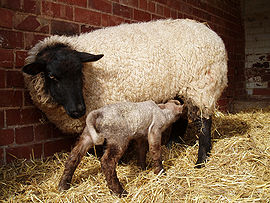
Mammal
Mammals are members of a class of air-breathing vertebrate animals characterised by the possession of endothermy, hair, three middle ear bones, and mammary glands functional in mothers with young...
s, domestic sheep
Domestic sheep
Sheep are quadrupedal, ruminant mammals typically kept as livestock. Like all ruminants, sheep are members of the order Artiodactyla, the even-toed ungulates. Although the name "sheep" applies to many species in the genus Ovis, in everyday usage it almost always refers to Ovis aries...
reproduction occurs sexually
Sexual reproduction
Sexual reproduction is the creation of a new organism by combining the genetic material of two organisms. There are two main processes during sexual reproduction; they are: meiosis, involving the halving of the number of chromosomes; and fertilization, involving the fusion of two gametes and the...
. Their reproductive strategy is very similar to other domestic herd
Herd
Herd refers to a social grouping of certain animals of the same species, either wild or domestic, and also to the form of collective animal behavior associated with this or as a verb, to herd, to its control by another species such as humans or dogs.The term herd is generally applied to mammals,...
animals. A flock of ewes is generally mated by a single ram, which has either been chosen by a farmer or has established dominance through physical contest with other rams (in feral
Feral
A feral organism is one that has changed from being domesticated to being wild or untamed. In the case of plants it is a movement from cultivated to uncultivated or controlled to volunteer. The introduction of feral animals or plants to their non-native regions, like any introduced species, may...
populations). Most sheep have a breeding season (tupping) in the autumn, though some are able to breed year-round.
Largely as a result of the influence of humans in sheep breeding, ewes often produce multiple lambs. This increase in the lamb births, both in number and birth weight, may cause problems in delivery and lamb survival, requiring the intervention of shepherds.
Sexual behavior
Ewes generally reach sexual maturity at six to eight months of age, and rams generally at four to six (ram lambs have occasionally been known to impregnate their mothers at two months). Ewes enter in to estrus cycles about every 17 days, which last for approximately 30 hours. In addition to emitting a scent, they indicate readiness through physical displays towards rams. Sheep may display homosexualityHomosexuality in animals
Homosexual behavior in animals refers to the documented evidence of homosexual and bisexual behavior in non-human species. Such behaviors include sex, courtship, affection, pair bonding, and parenting among same sex animals...
, which occurs in about eight percent of rams. Its occurrence does not seem to be related to flock hierarchy (as some homosexual behavior is in mammals), rather the ram's typical motor pattern for intercourse is directed at rams instead of ewes. The phenomenon of the freemartin
Freemartin
A freemartin or free-martin is an infertile female mammal which has masculinized behavior and non-functioning ovaries. Genetically and externally the animal is female, but it is sterilized in the womb by hormones from a male twin, becoming an infertile partial intersex...
, a female bovine that is behaviorally masculine and lacks functioning ovaries, is commonly associated with cattle, but does occur to some extent in sheep. The instance of freemartins in sheep may be increasing in concert with the rise in twinning (freemartins are the result of male-female twin combinations).
Rutting
Without human intervention, rams may fight during the rutRut (mammalian reproduction)
The rut is the mating season of ruminant animals such as deer, sheep, elk, moose, caribou, ibex, goats, pronghorn and Asian and African antelope....
to determine which individuals may mate with ewes. Rams, especially unfamiliar ones, will also fight outside the breeding period to establish dominance; rams can kill one another if allowed to mix freely. During the rut, even normally friendly rams may become aggressive towards humans due to increases in their hormone levels.

Pregnancy
Without ultrasoundUltrasound
Ultrasound is cyclic sound pressure with a frequency greater than the upper limit of human hearing. Ultrasound is thus not separated from "normal" sound based on differences in physical properties, only the fact that humans cannot hear it. Although this limit varies from person to person, it is...
or other special tools, determining if a sheep is pregnant is difficult. Ewes only begin to visibly show a pregnancy about six weeks before giving birth, so shepherds often rely on the assumption that a ram will impregnate all the ewes in a flock. However, by fitting a ram with a chest harness called a marking harness that holds a special crayon
Crayon
A crayon is a stick of colored wax, charcoal, chalk, or other materials used for writing, coloring, drawing, and other methods of illustration. A crayon made of oiled chalk is called an oil pastel; when made of pigment with a dry binder, it is simply a pastel; both are popular media for color...
(or raddle, sometimes spelled reddle), ewes that have been mounted are marked with a color. Dye may also be directly applied to the ram's brisket
Brisket
Brisket is a cut of meat from the breast or lower chest of beef or veal. The beef brisket is one of the eight beef primal cuts. The brisket muscles include the superficial and deep pectorals. As cattle do not have collar bones, these muscles support about 60% of the body weight of standing/moving...
. This measure is not used in flocks where wool is important, since the color of a raddle contaminates it.
After mating
Mating
In biology, mating is the pairing of opposite-sex or hermaphroditic organisms for copulation. In social animals, it also includes the raising of their offspring. Copulation is the union of the sex organs of two sexually reproducing animals for insemination and subsequent internal fertilization...
, sheep have a gestation
Gestation
Gestation is the carrying of an embryo or fetus inside a female viviparous animal. Mammals during pregnancy can have one or more gestations at the same time ....
period of around five months. Within a few days of the impending birth, ewes begin to behave differently. They may lie down and stand erratically, paw the ground, or otherwise act out of sync with normal flock patterns. A ewe's udder
Udder
An udder is an organ formed of the mammary glands of female quadruped mammals, especially ruminants such as cattle, goats, sheep and deer. The udder is a single mass hanging beneath the animal, consisting of pairs of mammary glands...
will quickly fill out, and her vulva
Vulva
The vulva consists of the external genital organs of the female mammal. This article deals with the vulva of the human being, although the structures are similar for other mammals....
will swell. Vaginal, uterine
Uterus
The uterus or womb is a major female hormone-responsive reproductive sex organ of most mammals including humans. One end, the cervix, opens into the vagina, while the other is connected to one or both fallopian tubes, depending on the species...
or anal prolapse may also occur, in which case either stitching or a physical retainer can be used to hold the orifice in if the problem persists.
Artificial insemination
In addition to natural insemination by rams, artificial inseminationArtificial insemination
Artificial insemination, or AI, is the process by which sperm is placed into the reproductive tract of a female for the purpose of impregnating the female by using means other than sexual intercourse or natural insemination...
and embryo transfer
Embryo transfer
Embryo transfer refers to a step in the process of assisted reproduction in which embryos are placed into the uterus of a female with the intent to establish a pregnancy...
s have been used in sheep breeding programs for many years. However, ovine AI is a relatively complicated procedure compared to other livestock. Unlike cattle or goats, which have straight cervices that can be vaginally inseminated, ewes have a curved cervix which is more difficult to access. Additionally, breeders were until recently unable to control their ewe's estrus cycles.
Historically, vaginal insemination of sheep only produced 40-60% success rates, and was thus called a "shot in the dark" (SID). In the 1980s, Australian researchers developed a laparoscopic insemination procedure which , combined with the use of progestogen and pregnant mare
Mare
Female horses are called mares.Mare is the Latin word for "sea".The word may also refer to:-People:* Ahmed Marzooq, also known as Mare, a footballer and Secretary General of Maldives Olympic Committee* Mare Winningham, American actress and singer...
's serum
Blood serum
In blood, the serum is the component that is neither a blood cell nor a clotting factor; it is the blood plasma with the fibrinogens removed...
gonadotropin
Gonadotropin
Gonadotropins are protein hormones secreted by gonadotrope cells of the pituitary gland of vertebrates. This is a family of proteins, which include the mammalian hormones follitropin , lutropin , placental chorionic gonadotropins hCG and eCG and chorionic gonadotropin , as well as at least two...
(PMSG
Equine chorionic gonadotropin
Equine chorionic gonadotropin is a gonadotropic hormone produced in the chorion of pregnant mares. Most commonly called pregnant mare's serum gonadotropin in the past, the hormone is commonly used in concert with progestogen to induce ovulation in livestock prior to artificial...
), yielded much higher success rates (50-80% or more), and has become the standard for artificial insemination of sheep in the 21st century.
Using a minor surgical procedure with almost no risk of injury or infection when performed properly, sheep laparoscopy allows the importation of improved genetics, even of breeds which may otherwise be non-existent in certain countries due to the regulation of live animal imports.
Lambing
When birth is imminent, contractionsContraction (childbirth)
-Throughout menstrual cycle:The uterus frequently contracts throughout the entire menstrual cycle, and these contractions have been termed endometrial waves or contractile waves. These appear to involve only the sub-endometrial layer of the myometrium...
begin to take place, and the fitful behavior of the ewe may increase. A normal labor may take one to several hours, depending on how many lambs are present, the age of the ewe, and her physical and nutritional condition prior to the birth. Though some breeds may regularly produce larger litters of lambs (records stand around nine lambs at once), most produce either single or twin lambs. At some point, usually at the beginning of labor or soon after the births have occurred, ewes and lambs may be confined to small lambing jugs
Glossary of sheep husbandry
The raising of domestic sheep has occurred in nearly every inhabited part of the globe, and the variations in cultures and languages which have kept sheep has produced a vast lexicon of unique terminology used to describe sheep husbandry...
. These pens, which are generally two to eight feet in length and width, are designed to aid both careful observation of ewes and to cement the bond between them and their lambs.
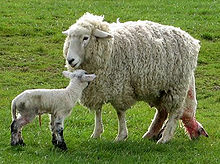
Miscarriage
Miscarriage or spontaneous abortion is the spontaneous end of a pregnancy at a stage where the embryo or fetus is incapable of surviving independently, generally defined in humans at prior to 20 weeks of gestation...
or stillborn
Stillbirth
A stillbirth occurs when a fetus has died in the uterus. The Australian definition specifies that fetal death is termed a stillbirth after 20 weeks gestation or the fetus weighs more than . Once the fetus has died the mother still has contractions and remains undelivered. The term is often used in...
. Reproductive failure is a common consequence of infections such as toxoplasmosis
Toxoplasmosis
Toxoplasmosis is a parasitic disease caused by the protozoan Toxoplasma gondii. The parasite infects most genera of warm-blooded animals, including humans, but the primary host is the felid family. Animals are infected by eating infected meat, by ingestion of feces of a cat that has itself...
and foot-and-mouth disease
Foot-and-mouth disease
Foot-and-mouth disease or hoof-and-mouth disease is an infectious and sometimes fatal viral disease that affects cloven-hoofed animals, including domestic and wild bovids...
. Some types of abortion in sheep are preventable by vaccinations against these infections.
In the case of any such problems, those present at lambing (who may or may not include a veterinarian
Veterinarian
A veterinary physician, colloquially called a vet, shortened from veterinarian or veterinary surgeon , is a professional who treats disease, disorder and injury in animals....
, most shepherds become accomplished at lambing to some degree) may assist the ewe in extracting or repositioning lambs. After the birth, ewes ideally break the amniotic sac
Amniotic sac
The amniotic sac is the sac in which the fetus develops in amniotes. It is a tough but thin transparent pair of membranes, which hold a developing embryo until shortly before birth. The inner membrane, the amnion, contains the amniotic fluid and the fetus. The outer membrane, the Chorion,...
(if it is not broken during labor), and begin licking clean the lamb. The licking clears the nose and mouth, dries the lamb, and stimulates it. Lambs that are breathing and healthy at this point begin trying to stand, and ideally do so between a half and full hour, with help from the mother. Generally after lambs stand, the umbilical cord
Umbilical cord
In placental mammals, the umbilical cord is the connecting cord from the developing embryo or fetus to the placenta...
is trimmed to about an inch (2.54 centimeters). Once trimmed, a small container (such as a film canister) of iodine
Iodine
Iodine is a chemical element with the symbol I and atomic number 53. The name is pronounced , , or . The name is from the , meaning violet or purple, due to the color of elemental iodine vapor....
is held against the lamb's belly over the remainder of the cord to prevent infection.
Postnatal care
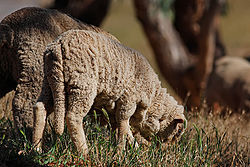
Colostrum
Colostrum is a form of milk produced by the mammary glands of mammals in late pregnancy. Most species will generate colostrum just prior to giving birth...
milk. Lambs that either fail to nurse or are prevented from doing so by the ewe require aid in order to live. If coaxing the pair to accept nursing does not work, one of several steps may then be taken. Ewes may be held or tied to force them to accept a nursing lamb. If a lamb is not eating, a stomach tube may also be used to force feed the lamb in order to save its life. In the case of a permanently rejected lamb, a shepherd may then attempt to foster an orphaned lamb onto another ewe. Lambs are also sometimes fostered after the death of their mother, either from the birth or other event.
Scent plays a large factor in ewes recognizing their lambs, so disrupting the scent of a newborn lamb with washing or over-handling may cause a ewe to reject it. Conversely, various methods of imparting the scent of a ewe's own lamb to an orphaned one may be useful in fostering. If an orphaned lamb cannot be fostered, then it usually becomes what is known as a bottle lamb—a lamb raised by people and fed via bottle.
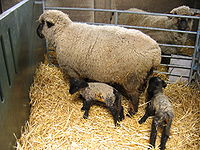
Glossary of sheep husbandry
The raising of domestic sheep has occurred in nearly every inhabited part of the globe, and the variations in cultures and languages which have kept sheep has produced a vast lexicon of unique terminology used to describe sheep husbandry...
is carried out – this includes ear tagging
Glossary of sheep husbandry
The raising of domestic sheep has occurred in nearly every inhabited part of the globe, and the variations in cultures and languages which have kept sheep has produced a vast lexicon of unique terminology used to describe sheep husbandry...
, docking
Docking (animal)
Docking is a term for the intentional removal of part of an animal's tail or ears. The term cropping is also used, though more commonly in reference to the cropping of ears, while docking more commonly—but not exclusively—refers to the tail. The term tailing is also commonly used...
, castration
Castration
Castration is any action, surgical, chemical, or otherwise, by which a male loses the functions of the testicles or a female loses the functions of the ovaries.-Humans:...
and usually vaccination
Vaccination
Vaccination is the administration of antigenic material to stimulate the immune system of an individual to develop adaptive immunity to a disease. Vaccines can prevent or ameliorate the effects of infection by many pathogens...
. Ear tags with numbers are the primary mode of identification when sheep are not named; it is also the legal manner of animal identification in the European Union
European Union
The European Union is an economic and political union of 27 independent member states which are located primarily in Europe. The EU traces its origins from the European Coal and Steel Community and the European Economic Community , formed by six countries in 1958...
: the number may identify the individual sheep or only its flock. When performed at an early age, ear tagging seems to cause little or no discomfort to lambs. However, using tags improperly or using tags not designed for sheep may cause discomfort, largely due to excess weight of tags for other animals.
Ram lambs not intended for breeding are castrated, though some shepherds choose to avoid the procedure for ethical, economic or practical reasons. Ram lambs that will be slaughtered or separated from ewes before sexual maturity are not usually castrated. In most breeds, lambs' tails are docked for health reasons. The tail may be removed just below the lamb's caudal tail flaps (docking shorter than this may cause health problems such as rectal prolapse), but in some breeds the tail is left longer, or is not docked at all. Docking is not necessary in short-tailed breeds
Northern European short-tailed sheep
Northern European short-tailed sheep are a group of sheep breeds and landraces from the British Isles, Scandinavia, and the area around the Baltic. They are thought to be derived from the first sheep brought to Europe by early farmers...
, and it is not usually done in breeds in which a long tail is valued, such as Zwartbles
Zwartbles
The Zwartbles is a breed of domestic sheep originating in the Friesland region of the north Netherlands. There it was primarily used for the production of sheep milk as well as lamb and mutton...
.
Though docking is often considered cruel and unnatural by animal rights activists, it is considered by sheep producers large and small alike to be a critical step in maintaining the health of sheep. Long, wooly tails make shearing more difficult, interfere with mating, and make sheep extremely susceptible to parasites, especially those that cause flystrike. Both castration and docking can be performed with several different instruments. An elastrator places a tight band of rubber around an area, causing it to atrophy
Atrophy
Atrophy is the partial or complete wasting away of a part of the body. Causes of atrophy include mutations , poor nourishment, poor circulation, loss of hormonal support, loss of nerve supply to the target organ, disuse or lack of exercise or disease intrinsic to the tissue itself...
and fall off in a number of weeks. This process is bloodless and does not seem to cause extended suffering to lambs, who tend to ignore it after several hours. In addition to the elastrator, a Burdizzo
Burdizzo
The Burdizzo is a castration device which employs a large clamp designed to break the blood vessels leading into the testicles. Once the blood supply to the testicles is lost, testicular necrosis occurs, and the testicles shrink, soften, and eventually deteriorate completely...
, emasculator
Emasculator
An emasculator is a tool used in the castration of livestock. Its function is to simultaneously crush and cut the spermatic cord, preventing hemorrhaging while still detaching the testis from the animal....
, heated chisel
Chisel
A chisel is a tool with a characteristically shaped cutting edge of blade on its end, for carving or cutting a hard material such as wood, stone, or metal. The handle and blade of some types of chisel are made of metal or wood with a sharp edge in it.In use, the chisel is forced into the material...
or knife
Knife
A knife is a cutting tool with an exposed cutting edge or blade, hand-held or otherwise, with or without a handle. Knives were used at least two-and-a-half million years ago, as evidenced by the Oldowan tools...
are sometimes used. After one to three days in the lambing jugs, ewes and lambs are usually sufficiently stabilized to allow reintroduction to the rest of the flock.
Commercial sheep breeding
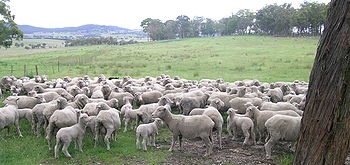
South America
South America is a continent situated in the Western Hemisphere, mostly in the Southern Hemisphere, with a relatively small portion in the Northern Hemisphere. The continent is also considered a subcontinent of the Americas. It is bordered on the west by the Pacific Ocean and on the north and east...
, Australia
Australia
Australia , officially the Commonwealth of Australia, is a country in the Southern Hemisphere comprising the mainland of the Australian continent, the island of Tasmania, and numerous smaller islands in the Indian and Pacific Oceans. It is the world's sixth-largest country by total area...
and New Zealand
New Zealand
New Zealand is an island country in the south-western Pacific Ocean comprising two main landmasses and numerous smaller islands. The country is situated some east of Australia across the Tasman Sea, and roughly south of the Pacific island nations of New Caledonia, Fiji, and Tonga...
sheep are usually bred on large tracts of land with much less intervention from the graziers or breeders. Merino
Merino
The Merino is an economically influential breed of sheep prized for its wool. Merinos are regarded as having some of the finest and softest wool of any sheep...
s, and much of the land in these countries does not lend itself to the mob intervention that is found in smaller flock breeding countries.
In these countries there is little need, and no option but for ewes to lamb outdoors as there are insufficient structures to handle the large flocks of ewes there. New Zealand ewes produce 36 million lambs each spring time, which is an average of 2,250 lambs per farm. Australian graziers, too, do not receive the financial support that governments in other countries provide to sheep breeders. Low-cost sheep breeding is based on large numbers of sheep per labour unit and having ewes that are capable of unsupervised lambing to produce hardy, active lambs.
Managerial aspects
For breeders intent on strict improvements to their flocks, ewes are classed and inferior sheep are removed prior to mating in order to maintain or improve the quality of the flock. Muffled (wooly) faces have long been associated with lower fertility rates. StudStud (animal)
A stud animal is a registered animal retained for breeding. The terms for the male of a given animal species usually imply that the animal is entire—that is, not castrated—and therefore capable of siring offspring...
or specially selected rams are chosen with aid of objective measurements, genetic information and evaluation services that are now available in Australia and New Zealand. The choice of mating time is governed by many factors including climate, market requirements and feed availability. Rams are typically mated at about 2.5% depending on the age of the sheep, plus consideration as to the size and type of mating paddocks. The mating period ranges from about 6 to 8 weeks in commercial flocks. Longer mating times result in management problems with lamb marking and shearing
Sheep shearing
Sheep shearing, shearing or clipping is the process by which the woollen fleece of a sheep is cut off. The person who removes the sheep's wool is called a shearer. Typically each adult sheep is shorn once each year...
etc.
After mating, in areas where fox
Fox
Fox is a common name for many species of omnivorous mammals belonging to the Canidae family. Foxes are small to medium-sized canids , characterized by possessing a long narrow snout, and a bushy tail .Members of about 37 species are referred to as foxes, of which only 12 species actually belong to...
es are a problem, a Coordinated Fox Control Project is held in conjunction with the local Rural Lands Protection Board (RLPB) and National Parks and Wildlife Service (NPWS) to facilitate a neighbourhood baiting campaign.
Good nutrition is vital to ewes during the last 6 weeks of pregnancy in order to prevent pregnancy toxaemia, especially in twin bearing ewes. Overfeeding, however, may result in over large single lambs and dystocia
Dystocia
Dystocia is an abnormal or difficult childbirth or labour. Approximately one fifth of human labours have dystocia.Dystocia may arise due to incoordinate uterine activity, abnormal fetal lie or presentation, absolute or relative cephalopelvic disproportion, or a massive fetal tumor such as a...
. Shearing ewes before lambing reduces the number of ewes that are cast (i.e. unable to rise unassisted), and the number of lambs and ewes that are lost. Lambs, too, are aided in finding the udder and suckling a shorn ewe.
After shearing ewes are typically placed in well sheltered paddocks that have good feed and water. Attention to ewes that are lambing varies according to the breed, size and locations of properties. Unless they are stud ewes it unlikely that they will receive intensive care. On stations
Station (Australian agriculture)
Station is the term for a large Australian landholding used for livestock production. It corresponds to the North American term ranch or South American estancia...
with large paddocks there is a policy of non-interference. On other properties the mobs are inspected by stockmen at varying intervals to stand cast ewes and deal with dystocia. Producers also sometimes quietly drift pregnant ewes away from ewes that have already lambed, in order to prevent mis-mothering.
Lambs are usually marked at 3 to 6 weeks of age, but a protracted lambing season may necessitate two markings.
Other countries
In the major sheep countries of Argentina, Uruguay, Brazil, Perú and Chile, breeders are also utilizing fleece testing and performance recording schemes as a means of improving their flocks.New research
For the first time in history, researchers at Chiswick CSIRO research station, between UrallaUralla, New South Wales
Uralla is a small town and on the Northern Tablelands, New South Wales, Australia. The town is located at the intersection of the New England Highway and Thunderbolts Way 465 kilometres north of Sydney and about 23 kilometres south west of the city of Armidale...
and Armidale, New South Wales
Armidale, New South Wales
Armidale is a city in the Northern Tablelands, New South Wales, Australia. Armidale Dumaresq Shire had a population of 19,485 people according to the 2006 census. It is the administrative centre for the Northern Tablelands region...
have used stem cell
Stem cell
This article is about the cell type. For the medical therapy, see Stem Cell TreatmentsStem cells are biological cells found in all multicellular organisms, that can divide and differentiate into diverse specialized cell types and can self-renew to produce more stem cells...
s to develop surrogate rams and bulls. These males then produce the viable semen of another male.
The approach in these sheep experiments involves irradiating a ram’s testes while placing stem cells from a second ram into the testes of the first, ram A. In the following weeks ram A produces semen the usual way, but is using the stem cells of ram B and therefore producing semen carrying the genetics of ram B rather than those of his own. Ram A therefore has effectively become a surrogate ram.
The viable semen is then implanted in the ewe and the many lambs born through this process are proving to be normal and healthy. DNA tests have proved that up to 10% of the lambs are sired by the surrogate ram and carry the genetics of the donor ram.

